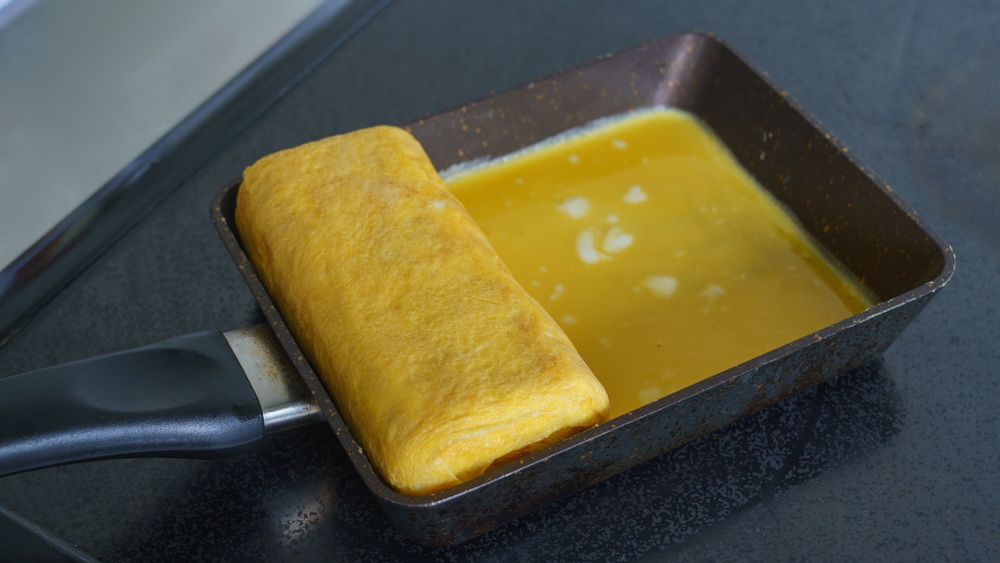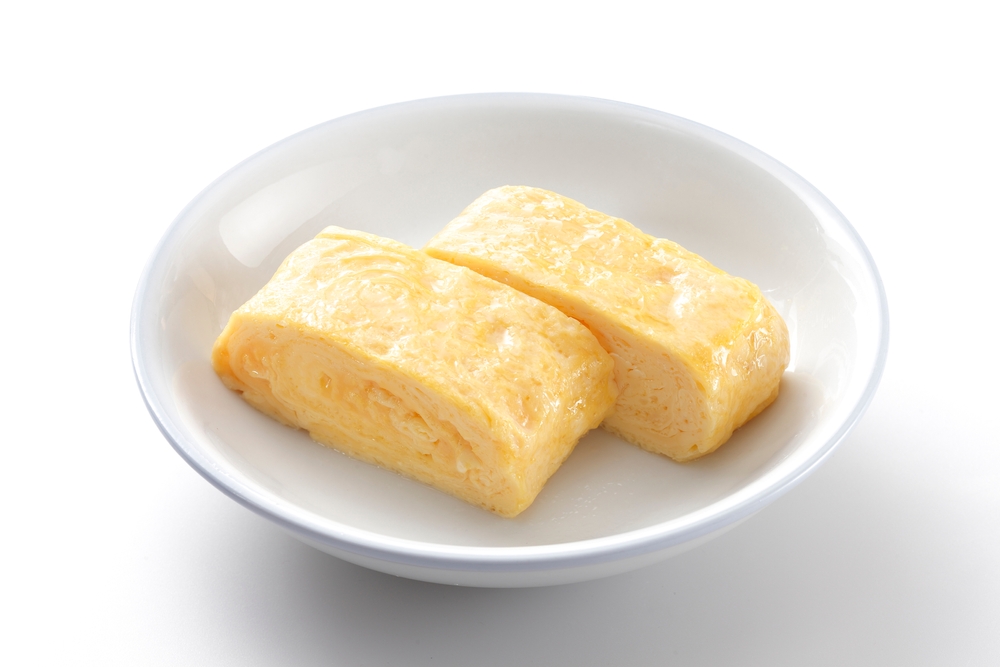Japanese Tamago Egg Recipe
Delicate and slightly sweet, Tamago, or tamagoyaki, is a quintessential Japanese rolled omelet that’s perfect for any sushi enthusiast. Its light, fluffy texture pairs beautifully with soy sauce and wasabi, offering a delightful contrast that melts in your mouth.
Crafted with a blend of eggs, dashi, mirin, and a touch of sugar, this dish offers a harmonious balance of savory and sweet. Whether you’re a seasoned cook or a novice in the kitchen, tamagoyaki is a simple yet elegant addition to any meal.
A tamago pan is ideal for achieving the traditional rectangular shape, but any small nonstick skillet will work. Serve it alongside sushi rice for an authentic experience, or enjoy it on its own as a savory, satisfying snack.

Japanese Tamago Egg: Ingredients
Eggs – The heart of tamagoyaki, providing the rich, creamy base that gives this rolled omelet its signature delicate texture.
Dashi Stock – This umami-rich broth infuses the omelet with a deep, savory flavor that elevates the overall taste profile, adding depth to each bite.
Mirin – A sweet rice wine that balances the dish’s flavors, adding a hint of sweetness and a silky glaze, essential for the traditional taste.
Soy Sauce – A touch of saltiness that complements the sweetness, creating a balanced flavor that brings out the complexity of the ingredients.
Vegetable Oil – Ensures the omelet layers cook smoothly and roll up seamlessly, creating that perfect golden-brown finish.
Recipe Tips
- Use a Tamago Pan for Perfect Rolls
While any small nonstick skillet can be used for tamagoyaki, a traditional tamago pan, typically 5×7 inches, is ideal. The square shape helps create evenly rolled layers, making each slice look neat and uniform. A rectangular pan also allows for more control when rolling and shaping the omelet. However, if a tamago pan isn’t available, a round skillet works fine, but expect slightly rounded edges. - Control the Heat for Fluffy Layers
Cooking tamagoyaki requires careful heat control to ensure each layer cooks evenly without browning too quickly. Medium heat is the sweet spot; too high, and the eggs will burn before they set properly. If the pan gets too hot, remove it briefly from the heat to cool slightly. This technique helps maintain the tender, airy texture of the omelet while preventing a rubbery finish. - Strain the Egg Mixture for a Smoother Omelet
For an extra silky texture, strain the egg mixture through a fine mesh sieve before pouring it into the pan. This process removes any remaining egg whites that haven’t fully mixed, creating a smoother, more uniform consistency. It might take a little extra time, but the result is a tamagoyaki with a beautiful, delicate mouthfeel.
What to Serve with Japanese Tamago Egg
- Steamed Sushi Rice
Tamagoyaki pairs beautifully with steamed sushi rice, creating a classic combination of sweet and savory. The fluffy rice balances the sweetness of the omelet and complements its delicate texture. Serve a small bowl of rice alongside each slice for a satisfying and authentic meal. - Miso Soup
A bowl of warm miso soup is the perfect accompaniment to tamagoyaki. The umami flavors in the soup complement the subtle sweetness of the rolled omelet, making it a balanced meal. The soup’s warmth also contrasts well with the slightly chilled tamagoyaki, offering a comforting dining experience. - Pickled Vegetables (Tsukemono)
Adding a side of pickled vegetables, such as cucumber or daikon, can provide a refreshing crunch to your meal. The tangy notes from the pickles cut through the richness of the tamagoyaki, adding a bright contrast. This pairing also adds a colorful element to your plate, enhancing the visual appeal.
FAQ
- What can I use as a substitute for dashi stock?
If you don’t have dashi, you can substitute with chicken or vegetable broth for a similar base. However, the distinct umami flavor of dashi is hard to replicate, so consider adding a pinch of seaweed or a dash of soy sauce for a closer match. - Why is my tamagoyaki not rolling smoothly?
If your tamagoyaki is not rolling smoothly, it may be due to the heat being too high or the egg layers being too thick. Adjust to a lower heat and pour thinner layers to ensure that each layer is pliable and easy to roll. - Can I make tamagoyaki without mirin?
Yes, you can make tamagoyaki without mirin, though it may lack the traditional sweetness. To mimic the flavor, try adding a little extra sugar or a splash of apple juice. It won’t be identical, but it will add the sweet note mirin provides. - How should I store leftover tamagoyaki?
Store leftover tamagoyaki in an airtight container in the refrigerator for up to 2 days. To reheat, place slices in a nonstick skillet over low heat until warmed through, or enjoy it cold, as it retains its flavor well.

Japanese Tamago Egg
Ingredients
Method
- Assemble all the ingredients before beginning.
- In a mixing bowl, beat the eggs thoroughly. Incorporate the dashi stock, sugar, mirin, and soy sauce, whisking until the sugar fully dissolves. Lightly coat a nonstick skillet with vegetable oil and heat it over medium heat.
- Pour a thin layer of the egg mixture into the preheated pan, swirling it gently to ensure even coverage. Allow the layer to cook until the bottom is firm, but the top remains slightly runny, approximately 1 minute.
- Using a spatula, lift one edge of the cooked layer and carefully roll it up.
- Push the rolled omelet to one side of the skillet. Lightly grease the pan again, pouring another thin layer of the egg mixture. Lift the initial roll slightly, letting the new layer flow underneath.
- Roll the existing omelet into the freshly cooked layer and shift it to the edge of the skillet. Repeat this process with the remaining egg mixture, adding more oil if required between layers.
- Transfer the rolled omelet to a serving plate and cut it into 6 equal portions.






